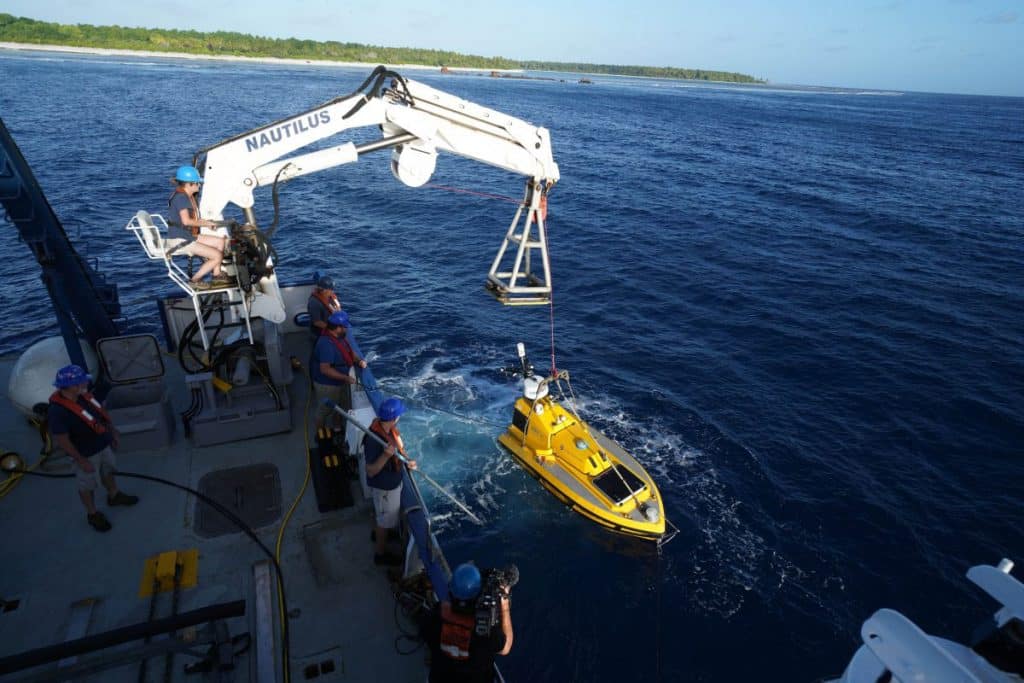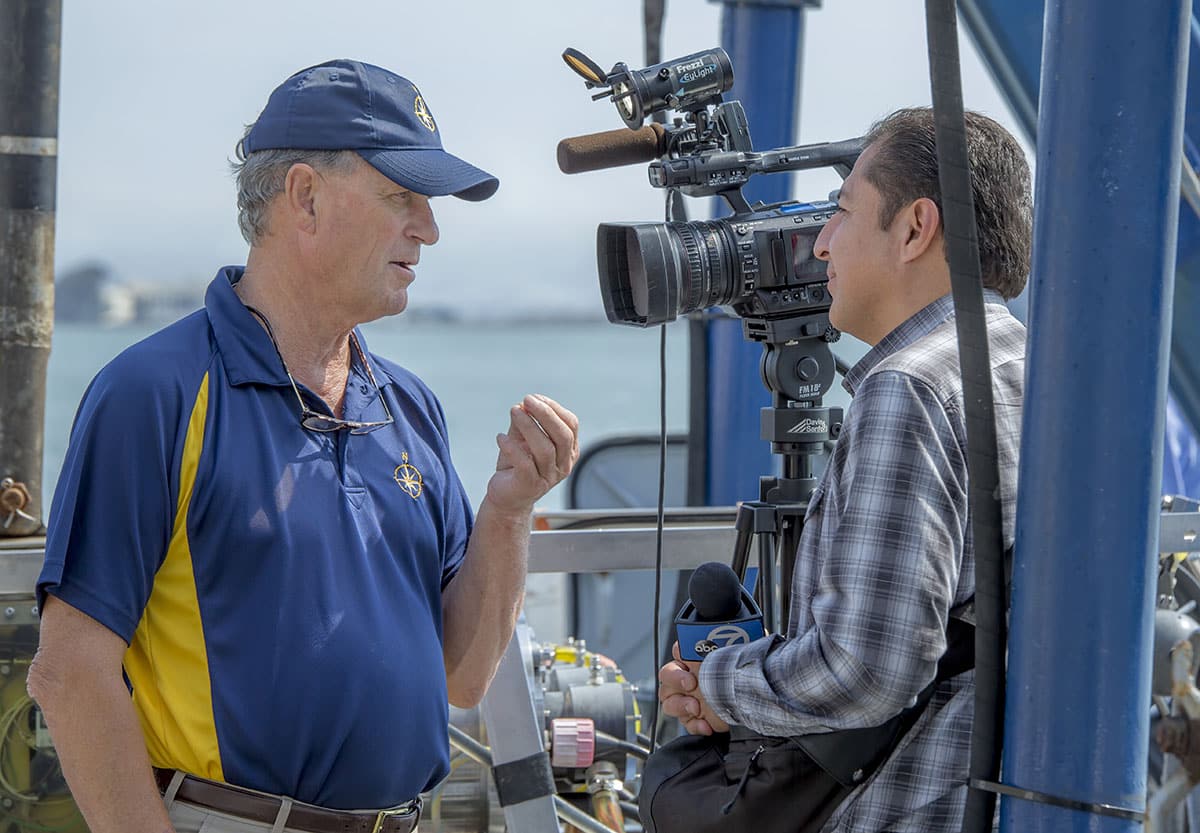Ballard prepares to head up ‘Lois and Clark’ expedition to map underwater America
February 24, 2020 | Brett Davis

Legendary underwater explorer Robert Ballard is about to embark on perhaps his most ambitious voyage yet — a modern-day version of the Lewis and Clark expedition to map a newly enlarged United States of America. America doubled in size when Napoleon, forced to pay war debts after losing to England, sold the Louisiana Purchase to Thomas Jefferson for $15 million. He enlisted Meriwether Lewis and William Clark to find out what he had bought. In the 1980s, President Reagan again doubled the size of the United States, Ballard says, not for $15 million “but for the price of the pen” he used to sign a proclamation extending America’s jurisdictions out to 200 miles from all of its territory as part of the Law of the Sea Convention, which lays out rights and responsibilities for nations using the world’s oceans. Due to America’s extensive coastlines, “it’s an inordinate amount of real estate,” Ballard says, “yet we have better maps of Mars than we have of the United States of America.” The National Oceanic and Atmospheric Administration (NOAA) is now home to the Office of Ocean Exploration and Research, which Ballard says is the first such office in the history of the United States. “Its charter is to conduct a massive series of expeditions, to go out and map and characterize what we own with a view towards what’s now emerging in the economic sector, called the blue economy,” he says. “We have the next 10 years to map the underwater America. It’s pretty exciting, actually.” It could also be a modern windfall comparable to the economic growth that occurred after the Louisiana Purchase. The oceans could be used to feed an ever-growing population and for the mining of rare earth minerals, critical to modern electronics.
 Ballard (left) on the deck of the EV Nautilus. Photo: Ocean Exploration Trust “It isn’t the second Lewis and Clark expedition, because Lewis and Clark had a Corps of Discovery, which is what he called his men, and they were all men except for Sacajawea,” Ballard says. “We call our team the Corps of Exploration, and 55 percent of our team are women in positions of leadership and authority, so we call it the Lois and Clark expedition. So, it’s pretty exciting and we get underway in March.” Unlike some of his earlier expeditions — such as to find the location of the Titanic, which he did in 1985, or the German battleship Bismarck, which he found a few years later — Ballard and his team don’t know exactly what they’re looking for. “We are literally going, I have to say, boldly going, where no human has gone before in America,” he says. Lewis and Clark brought their findings back to Jefferson after their journey, which took nearly 2.5 years. Jefferson wasn’t able to follow their exploits in real time, but scientists will be able to do that with the Corps of Exploration. The expedition will use a ship named the Exploration Vessel Nautilus, or EV Nautilus, which is currently in drydock getting a new engine. “We’re operating the ship almost in an analogous way to an emergency room in a hospital,” he says. He cites the example of an ambulance pulling up at 2 a.m. Emergency room technicians don’t know if they will be dealing with a baby being born, a gunshot victim, a heart attack or something else. Whatever it is, they stabilize the patient and then call in a local doctor with particular expertise who can get there in half an hour. Ballard says if his team finds something extraordinary under the water, “no matter where, or when, or how deep … we will deliver the brightest minds in America to the spot of the discovery in 30 minutes.” The EV Nautilus has dynamic positioning, meaning it can hover over an area more like a helicopter than a traditional ship. The underwater robots connect to the ship via fiber optic cable and the ship connects to a high-bandwidth satellite. “So, imagine we discover something. We go into full dynamic positioning, so we are now hovering and the [robotic] vehicle is looking at it with 4K cameras and has manipulators. That is instantly put in our command center,” he says.
Ballard (left) on the deck of the EV Nautilus. Photo: Ocean Exploration Trust “It isn’t the second Lewis and Clark expedition, because Lewis and Clark had a Corps of Discovery, which is what he called his men, and they were all men except for Sacajawea,” Ballard says. “We call our team the Corps of Exploration, and 55 percent of our team are women in positions of leadership and authority, so we call it the Lois and Clark expedition. So, it’s pretty exciting and we get underway in March.” Unlike some of his earlier expeditions — such as to find the location of the Titanic, which he did in 1985, or the German battleship Bismarck, which he found a few years later — Ballard and his team don’t know exactly what they’re looking for. “We are literally going, I have to say, boldly going, where no human has gone before in America,” he says. Lewis and Clark brought their findings back to Jefferson after their journey, which took nearly 2.5 years. Jefferson wasn’t able to follow their exploits in real time, but scientists will be able to do that with the Corps of Exploration. The expedition will use a ship named the Exploration Vessel Nautilus, or EV Nautilus, which is currently in drydock getting a new engine. “We’re operating the ship almost in an analogous way to an emergency room in a hospital,” he says. He cites the example of an ambulance pulling up at 2 a.m. Emergency room technicians don’t know if they will be dealing with a baby being born, a gunshot victim, a heart attack or something else. Whatever it is, they stabilize the patient and then call in a local doctor with particular expertise who can get there in half an hour. Ballard says if his team finds something extraordinary under the water, “no matter where, or when, or how deep … we will deliver the brightest minds in America to the spot of the discovery in 30 minutes.” The EV Nautilus has dynamic positioning, meaning it can hover over an area more like a helicopter than a traditional ship. The underwater robots connect to the ship via fiber optic cable and the ship connects to a high-bandwidth satellite. “So, imagine we discover something. We go into full dynamic positioning, so we are now hovering and the [robotic] vehicle is looking at it with 4K cameras and has manipulators. That is instantly put in our command center,” he says.
“We have a very high satellite link of 20 megabytes so we can send high-definition images ashore. And we have built for this project what we call the Inner Space Center, sort of like Houston underwater, based at the Graduate School of Oceanography at the University of Rhode Island … there’s a staff standing watch there also, 24/7.” Experts from around the country can be quickly rousted to investigate a discovery at any time. “Imagine it’s a guy or gal and they’re an expert. It’s Sunday morning so they’re probably in bed. So, the phone rings next to their bed. They know something’s up. We say, ‘boot up your laptop.’ While they’re in bed, we will stream the discovery right into their laptop.” The experts can also be patched in by phone and help direct an operation in real time, or travel to their universities to remote consoles, “so they think they are physically in the room.” They can even scramble their own team, also on consoles, and “take over the ship and prosecute the discovery,” he says. The findings can also be streamed into classrooms around the country and on to the web and social media. In other words, the days of waiting on an expedition to report back are long gone. “I lived that for 60 years,” Ballard says. “So, yeah, this is a different world.”
Ballard will make a keynote address at AUVSI Xponential on Tuesday, May 5. To follow the Corps of Exploration’s expedition, go to https://nautiluslive.org/ or http://www.oceanexplorationtrust.org/.
Below: An unmanned surface vessel prepares to launch from the EV Nautilus. Photo: Ocean Exploration Trust


